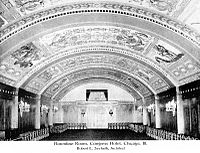Robert Seyfarth Architect
Robert Seyfarth (/ˈsaɪfərθ/ SY-fərth) was an American architect based in Chicago, Illinois.Having spent the formative years of his professional career working for the noted Prairie School architect George Washington Maher, and having been a member of the influential Chicago Architectural Club, Seyfarth was a product of the Chicago School of Architecture. Although his early independent projects directly reflected Maher’s stylistic influences, as his own style developed Seyfarth’s work became distinguished more as a distillation of prevailing revivalist architecture, characterized not by the frequent devotion to detail that typified the movement but by strong geometry, a highly refined sense of proportion, and the selective, discriminating use of historical references. Although any use of these references was condemned by many of the proponents of what was seen as "modern" architecture in the ensuing years, "the neoclassical impulse...was an effort to purge American architecture of the wilder excesses of historical revivalism [of the nineteenth century] by returning to fundamental architectural principles. The ideals this architecture sought to express were the very ones the most inventive Chicago architects were trying to embody in their own work - order, harmony, and repose...". As a result, the conception of modern architecture was anything but a static event. “Architects and critics engaged in lively debates concerning the definition of modern architecture and the future direction of building design. This discourse reflected the development of diverse architectural ideologies and forms that ranged from Beaux-Arts classicism to streamlining.”. The case for the use of historic references in modern architecture was made by no less than William Adams Delano (1874-1960), who was considered to be one among the "new generation of architects [who] shaped and developed American taste, producing a style leavened with erudite abstraction and sparing composition”. Delano argued that if a project was “handled with freedom and...answered the needs of our present day clients, it will be really expressive of our own time”. Seyfarth opted to take his career down this divergent path, and in doing so created a legacy of architecture that “speaks of good breeding with an independent spirit.”
Search
Robert Seyfarth on Wikipedia
External resources
- http://books.google.com/books?id=V9owAQAAMAAJ&printsec=frontcover&dq=%22the+home+you+longed+for%22&hl=en#v=onepage&q=%22the%20home%20you%20longed%20for%22&f=false
- http://cookcountyassessor.com/officehistory.aspx
- http://digital-libraries.saic.edu/cdm4/results.php?CISOOP1=all&CISOFIELD1=CISOSEARCHALL&CISORESTMP=results.php&CISOVIEWTMP=item_viewer.php&CISOMODE=grid&CISOGRID=thumbnail%2CA%2C1%3Btitle%2CA%2C1%3Bdate%2CA%2C0%3Blength%2C200%2C0%3Bnone%2CA%2C0%3B20%3Btitle%2Cnone%2Cnone%2Cnone%2Cnone&CISOBIB=title%2CA%2C1%2CN%3Bcreato%2CA%2C0%2CN%3Bdate%2C200%2C0%2CN%3Bnone%2CA%2C0%2CN%3Bnone%2CA%2C0%2CN%3B20%3Btitle%2Cnone%2Cnone%2Cnone%2Cnone&CISOTHUMB=20+%284x5%29%3Btitle%2Cnone%2Cnone%2Cnone%2Cnone&CISOTITLE=20%3Btitle
- http://learn.lakeforest.edu/archon/?p=collections/findingaid&id=60&q=&rootcontentid=5462
- http://tigger.uic.edu/depts/ahaa/imagebase/intranet/chiviews/page183.html
- http://winnetkahistory.org/gazette/175-chestnut-street
- http://www.bapa.org/article.asp?articleid=105
- http://www.blueisland.org/landmarks
- http://www.georgemaher.com
- http://www.robertseyfartharchitect.com
